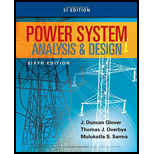
Concept explainers
A balanced three-phase load is connected to a
(a) Line currents for phases A, B, and C.
(b) Line-to-neutral voltages for all three phases at the load.
(c) Apparent. active, and reactive power dissipated per phase, and for all three phases in the load.
(d) Active power losses per phase and for all three phases in the phase conductors.
Trending nowThis is a popular solution!

Chapter 2 Solutions
Power System Analysis & Design
- Problem 3 (a) Consider x[n] = { 0, 1, 0 ≤ n ≤N-1 otherwise _and_h[n] = { 1, 0 ≤ n ≤M-1 0, otherwise with N > M. Plot the sequence y[n] = x[n] × h[n]. Make sure to specify the amplitude values * and time indices n of y[n] where y[n] is constant. (b) Express the number L of samples of y[n] that are non-zero in terms of M and N. (c) Consider x'[n] = { 0, 1, N₁ ≤ n ≤ N₂ otherwise 1, M₁n M₂ and h'[n] = = 0, otherwise ', and assume that №2 - N₁ = N-1 and M2 - M₁ = x'[n] h'[n] is equal to a shifted version of y[n]. What is the value of the shift? - = M 1. Show that the sequence y'[n] =arrow_forwardHome Work Calculate I, and I2 in the two-port of Fig. below 20 211=602 2/30° V V₁ %12=-142 721=-j4 2 Z22=82 + V₂ 94arrow_forwardHW-2: Consider the loop of Figure below. If B = 0.5az Wb/m2, R = 20 2, e = 10 cm, and the rod is moving with a constant velocity of 8ax m/s, find (a) The induced emf in the rod (b) The current through the resistor y I 00 121 & B (in) 60 Answer: (a) 0.4 V, (b) 20 mA &arrow_forward
- Write a Verilog program to design the 4-bit ripple carry counter using the instantiation process available in Verilog HDL and write the stimulus program to check the functionality of the design. Assume 4-bit ripple carry counter is designed from a T-flipflop and T-flipflop is designed from a D- flipflop.arrow_forwardHW3: A 9.375-GHz uniform plane wave is propagating in polyethylene (&-2.26). If the amplitude of the electric field intensity is 500 V/m and the material is assumed to be lossless, find: (a) the phase constant; (b) thearrow_forwardHW1: The location of the sliding bar in Figure below is given by x = 5t + 2t³, and the separation of the two rails is 20 cm. Let B = 0.8x2a, T. Find the voltmeter reading at (a) t = 0.4 s; (b) x = 0.6 m.arrow_forward
- For the circuit shown in Fig. 2.18, he =1.1 K2, hfe =50. Find Avf, Rif and Rof. { Ans: -3.2; 1935; X2807. Ans:-3-2;193;728. Vcc Rs=10kQ RF = 40kQ Re=4KQ -ov Vsarrow_forwardFor the system shown in figure below, the per unit values of different quantities are E-1.2, V 1, X X2-0.4. Xa-0.2 Determine whether the system is stable for a sustained fault. The fault is cleared at 8-60°. Is the system stable? If so find the maximum rotor swing. Find the critical clearing angle. E25 G X'd 08 CB X2 F CB V28 Infinite busarrow_forward17 For the circuit shown in Fig. 2.20, the transistors are identical and have the following parameters: hfe = 50, hie 1.1K, hre = 0, and hoe = 0. Calculate Auf, Rif and Rof. 25 V {Ans #45.4; 112 KM; 129 150k 47k www www +11 www 10k 6 4.7k 50μF Rif R₂1000 w 4.7k 47k Vo Q2 33k 4.7k ww 50µF 5μF 4.7k 1 R₁ Rofarrow_forward
- For the circuit shown in Fig. 2.18, he =1.1 K2, hfe =50. Find Avf, Rif and Rof. { Ans: -3.2; 1935; X2807. Ans:-3-2;193;728. Vcc Rs=10kQ RF = 40kQ Re=4KQ -ov Vs Fig. 2.18 Circuit for Q5.arrow_forwardThe circuit of Fig. 2.16 is to have Af=-1mA/V, D=1+ BA = 50, a voltage gain of -4, Rs =1KQ, and hfe = 150. Find RL, Re, Rif and Rof.. Vcc www RL OV Ans: 4 kor; 98053150 KS;∞. { An Re Fig. 2.16 Circuit for Q3.arrow_forwardDuring the lab you will design and measure a differential amplifier, made with an opamp. inside generator R5 ww 500 V1 0.1Vpk 1kHz 0° R6 w 50Ω R1 ww 10ΚΩ VCC C1 balanced wire R3 w 15.0V signal+ 100nF U1A TL082CP ground 2 signal- R4 w C2 Question5: Calculate R3 and R4 for a 20dB. 100nF VEE -15.0V R2 ww 10ΚΩarrow_forward
 Power System Analysis and Design (MindTap Course ...Electrical EngineeringISBN:9781305632134Author:J. Duncan Glover, Thomas Overbye, Mulukutla S. SarmaPublisher:Cengage Learning
Power System Analysis and Design (MindTap Course ...Electrical EngineeringISBN:9781305632134Author:J. Duncan Glover, Thomas Overbye, Mulukutla S. SarmaPublisher:Cengage Learning
